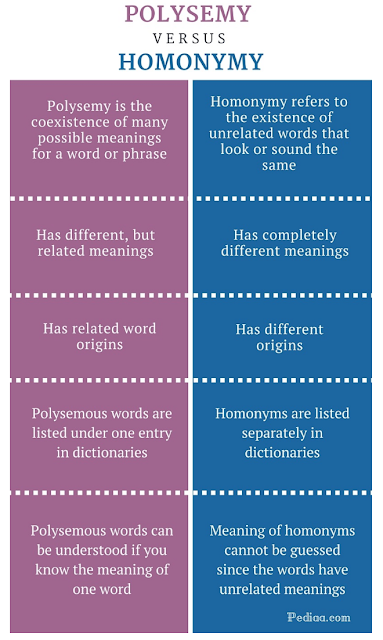Click here ! for the thesis pdf.
1.
Definition
of Polysemy
Polysemy
stands from POLY = MANY and SEMY = SIGN. Polysemy
refers to the coexistence of many possible meanings for a word or phrase. It has
different but related meaning.
Word becomes polysemous if it can be used to express different meanings. The
difference between these meanings can be obvious or subtle. It is sometimes
difficult to determine whether a word is polysemous or not because the
relations between words can be vague and unclear. But, examining the origins of
the words can help to decide whether a word is polysemic or homonymous. Note
that polysemy is different from homonymy;
two words are homonyms if they look / sound the same, but have completely
unrelated meanings. On the other hand, polysemy refers to the different
meanings that a single word has but it still have relation.
2. The Differences Between Polysemy
and Homonymy
3.
Examples of
Polysemy
a. In English
ü
head = kepala
(bagian tubuh) – kepala (pimpinan)
ü
water = air
– menyiram
ü
wood = kayu
– hutan
ü
milk = susu
– memerah susu
b.
In Bahasa
ü
Jatuh, in examples :
1. Toni jatuh dari motor.
2. Harga cengkeh jatuh pada tahun ini.
3. Setelah tiba di rumah, ia jatuh sakit.
4. Nilainya jatuh sehingga harus mengulang lagi di kelas XI.
ü Kepala, in examples :
1.
Kepala = bagian tubuh paling atas
2.
Kepala kereta api = lokomotif
3.
Kepala stasiun = pimpinan stasiun
ü Buah, in examples :
1.
Buah apel merupakan oleh oleh khas kota malang
: kata buah
bermakna buah buahan
2.
Ayana memiliki buah
hati yang bernama Yuki
: kata buah
bermakna anak
3.
Nadzar membawa buah
tangan dari kota Madura
: kata buah
bermakna oleh-oleh
ü Darah, in examples :
1.
Saya masih
punya hubungan darah dengan keluarga Bu Rani.
(darah = kesaudaraan)
2. Tubuhnya berlumuran darah setelah kepalanya
terbentur tiang listrik.
(darah = yang
berada dalam tubuh)
REFERENCES

